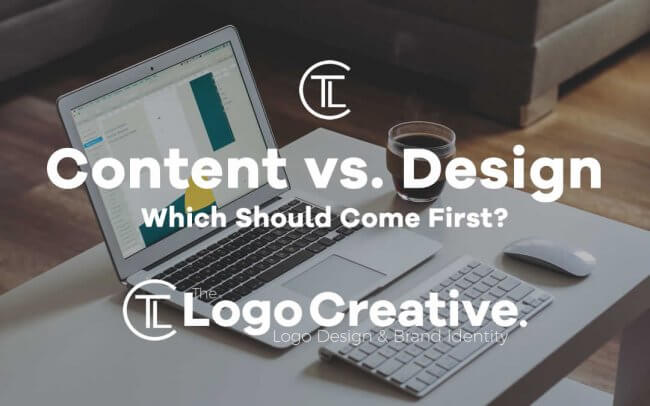What’s more important content or design? This has been an ongoing debate in the design industry for years and is brought up by the majority of creative professionals when discussing new projects. It’s an equal discussion for both digital and print-based design, Join us in this article as we discuss Content vs. Design – Which Should Come First?
When it comes to content vs design, I would say both content and design walk the same path and are equally important as the design is the body and the content is the soul of the design they both contribute to making something special and unique.
Digital marketing is, in essence, the act of promoting through online mediums. Instead of stores, we have websites that don’t just sell products, but they also “sell” information, usability, and design.
An online medium is a place where brands and consumers connect and exchange value. Content and design are two of the most essential elements of effective marketing and sales performances, and yet there’s a lot of confusion concerning the collaboration between the two distinct but highly interconnected aspects.
As a simpler explanation, many companies and single entrepreneurs find it hard to decide the sequence in which they work on their updates. The designers expect the content first and the writers expect a design to fit their words into. The pressing question is…
Do they create the content first? Or the design?
Well, in today’s post, we’re going to explore this important question, which I’m confident that even you yourself have explored at least once. To arrive at a conclusion, we need to start from scratch and seek the roots of this problem. Let’s get started.
Table of Contents
What is the Role of Content?
The primary purpose of content is to bring relevant traffic to the website. The only way you can be constantly discovered by new people is to generate organic traffic using digital marketing practices, which can’t be performed without content.
Another purpose of your content is to create a connection (rapport) between your brand and your website visitors. The next point would be to convert them into email subscribers (leads) and take the relationship to the next level. Of course, this can be done mainly through information and communication (content).
What is the Role of Design?
The role of design is to highlight the content of your website and to optimize the quality of your users’ experience. Web design and web development are no longer separate fields. They both serve to the same purposes: the improvement of website usability and the improvement of the UX.
It has been proven that 80% of web users are skimming the content they consume online – the rest is brand exploration.
Great content will never shine without the proper design. Nowadays, visual content, which is created only by designers, is one of the most effective marketing elements a platform can use. As a matter of fact, studies show that posts which contain visual assets like images or graphics produce 650 percent higher engagement.
Therefore, amazing content cannot be crafted without the implication of the designer, whose role is to complete the equation by providing design guidelines.
Why Content Should Come First?
A content-first design-after approach is preferred by most designers. Most reputable contributors from popular magazines like InVision, Adobe Smashing Machine, and more are constantly emphasizing the real benefits of placing content first in the sequence.
Let’s have a look why.
Content Creates a Structure for Design
Generally, if a web designer is given the green light over the final result, his imagination will run wild and he’ll often deliver something different than expected.
Content acts like a fence filled with direction boards. The designer should understand the essence of the message that needs to be delivered and work “within the boundaries” of the final scope.
Every designer should acknowledge the hooks for the readers, the actions that the website visitors must perform, and the strategy of the sales sequence. Obviously, content can provide these details.
A Content Strategy Provides the Big Picture
When designers are to begin their work, their efficiency can be significantly boosted if they understand the big picture of your marketing strategy.
A content marketing strategy is basically the illustration of how things are going to work, and how things are going to be in the nearest future. A designer needs to know what type of media they’ll need to produce, and it gives them time to prepare for it.
Good designers will pick up the pieces and help at improving the conversion rate by emphasizing certain places of the website.
Content First is More Convenient
By writing the content first and producing the design second, you’re not only saving time but also a lot of energy and nerves.
Many writers feel the need of updating/improving their work only after its published. The fact that their work is published makes them more critical in thinking, so they’ll often request content modifications.
When that happens, the designer has to go back to that post and produce modifications to the source file, which is an absolute waste of time. To avoid this from happening, simply write content first.
There’s No Marketing or Business Without Content
Organic traffic, the best type of available traffic is often generated as a result of an effective SEO strategy. Since SEO is interconnected with content, it means that content comes first even in marketing. A designer should know which parts of the post are optimized, which keywords are targeted, and he should acknowledge the end goal.
For this reason, content that is later improved by design will perform better in the search engines most of the time.
Why Design Should Come First?
Since the design-first option is not as popular, it’s easy to figure that the benefits involved are less attractive for most organizations. Nevertheless, they still exist.
Design Creates a Structure for Content
Some work cultures and teams do better when it comes to filling in the dots instead of developing the entire structure. Also, good writers can often do great at fitting their content within particular constraints.
A simple design mockup or sketch can help content writers align their information with the design’s expectations. Some of the most common situations in which this benefit arises are preheaders, email subject lines, video development, social media posts and ads, infographics, and search engine descriptions.
The Content’s Efficiency Can Be Boosted by Brilliant Design and UX
Let’s say, for example, that a company has three highly experienced designers and two talented yet unexperienced content writers. In this case, who do you see fit to lead the way?
We can argue about this, or we can simply conclude that a brilliant design template or sketch, filled with practical suggestions concerning the structure and alignment of the content, will improve the quality of the end result.
Some Content Demands Design First
How can you write an article based on an infographic if the infographic hasn’t yet been developed? You have the information, right, but what about its order? The designer must create a kinesthetic design of the information you’re about to write, and he must do it before you start writing.
Landing pages or squeeze pages – content or design first? Tough to answer. My opinion is that landing pages are the work of designers, and the content writers are there to fit the plan of the artists.
Content & Design Together as One – The Perfect Solution
While it’s quite agreeable that content first and design after is a more suited approach in most of the cases, there’s a solution that’ll end this problem once and for all.
Content and design, together as one. This is a great solution because it solves a lot of challenges and issues, but also because it isn’t hard to implement at all. Developing a communication protocol that’ll serve both writers and designers is the first step, while consistent practice is the second.
The Non-Linear Approach is the Best
A linear approach goes like this: the writer creates the final content piece, the designer looks over it and suggests (or demands) modifications, and finally the writer is going through the work again. Or it could be the opposite – the design comes first, the writer doesn’t agree, and the story goes on.
The worst part is that time, money, and energy is wasted along the way. A non-linear approach works best because it involves real-time collaboration. Both the writer and the designer establish the content strategy together, and both get the chance to agree or disagree.
You Need a Fused Team
You should only differentiate your designers from writers to make distinct and obvious reference differences. However, you shouldn’t split them into two sectors because they need to stay together.
Plan Your Content Ahead
Your designers need time to prepare their sketches and drafts, and they need to know what to look after. A piece of content can contain many types of visual content: graphics, infographics, images, videos, screenshots, and so on.
Designers need time to do their work properly. They must research, they must edit, they must often create original pictures and graphics, and they must be focused and patient. You can’t rush a designer’s job, or you’ll end up with average results. For that reason, you should start planning your content ahead.
Exceptional Content is Essential
If you want to connect with your target audience, you’ll need both great content and great design. Now – the word “great” is very subjective, so I’ll give you some more details to help you understand:
What is exceptional content?
- Information that is easily digestible, expressed through short and concise sentences.
- Articles/blogs that convey a message effectively, that solve problems and satisfy needs, and that help readers improve their lives one way or another.
- Videos that inspire and motivate the viewer, videos that are comprised of powerful emotional cues delivered by images or acting.
- Infographics that inform and educate the target audience, providing extremely practical advice.
- Valuable information that is beautifully structured and organized.
Here’s good advice: it doesn’t matter how good your content and design is if the texts you are developing aren’t correct.
Great Design is Key
Just like exceptional content is needed, a great design is key for productive business performance. Let’s see what “great design” means.
What is a great design?
- Branded layout – a web designer is responsible for developing the layout of the website. Great designers who understand and acknowledge the company’s culture will be able to show it through their design choices.
- Content – compelling content that is placed in the right places is an important component of good web design.
- Color – what will the color of your design transmit? The psychology of color is an important factor that designers must take into account.
- Font – another important issue that needs to be discussed and established once and for all.
- Visual elements – from photos to videos and graphics, your design must be comprised of high-quality elements that enhance the message of your content and brand.
You Can’t Have Design Without Content and the Other Way Around
Content and design are two separated yet highly connected aspects that every website owner, business, or agency must deal with at one point or another. The difference between successful and unsuccessful marketing is often defined by the strategy and organization of the team as a whole.
Learn to put design and content development in the same basket, help your employees develop a beautiful and productive collaboration, and let there be balance!
 Author Bio
Author Bio
Tiffany Harper is a journalist and an experienced writer from New York, USA. The range of her interests is wide: design, technologies, digital marketing. Now she works with Do My Writing review in different areas.

